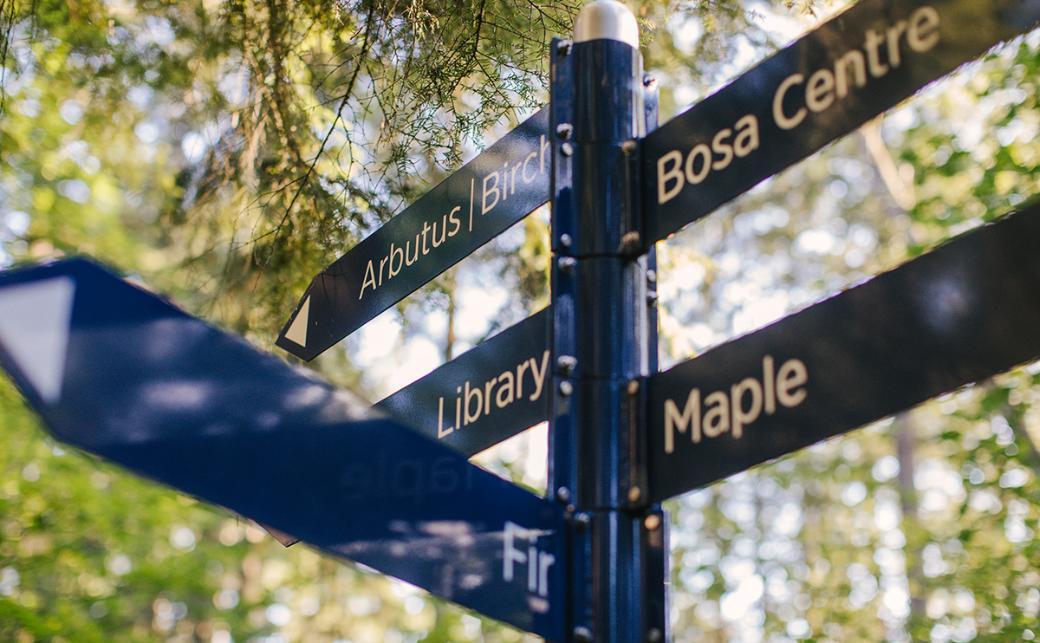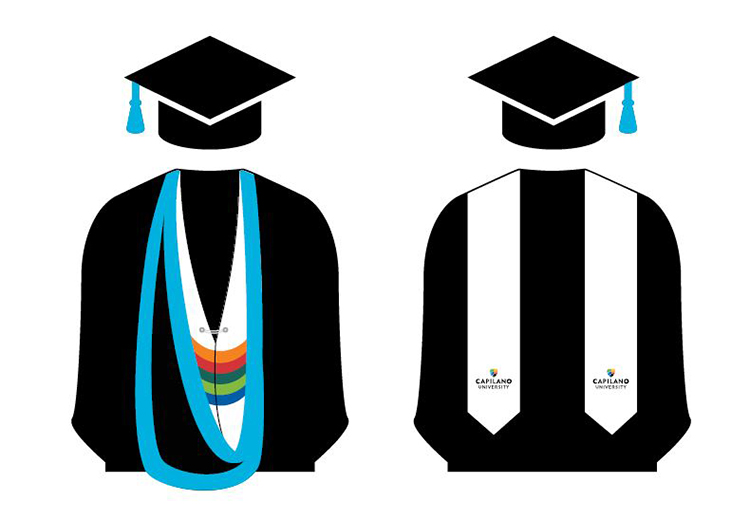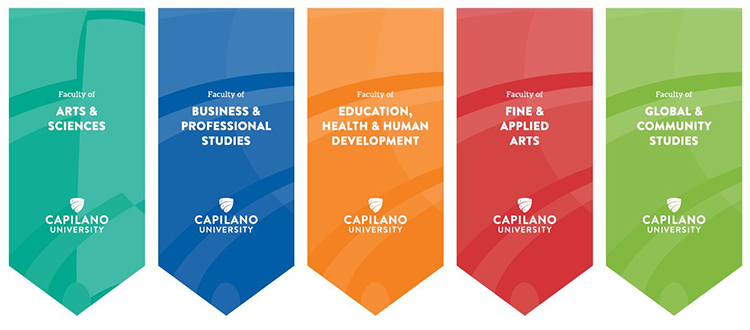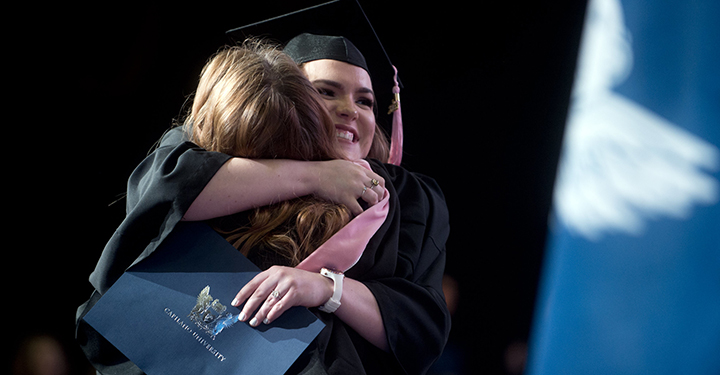
Ever wondered about the traditions of a convocation ceremony? Click on the items below to learn more about the Convocation ceremony at Capilano University.
The cap and gown are traditional regalia each university student dons to mark the milestone of their achievements.
Why a cap and gown?
Academic regalia dates back to medieval times when university studies were often held in cold, unheated churches and the robes were worn for warmth. The monks would often have their heads shaved in the traditional tonsure (shaved head for humility). Therefore, the hoods were necessary for warmth, as well.
The hoods were later replaced by skull caps, which we now know as our classic mortarboard. In the 19th century, the hoods and robes began to take on various colours and styles to indicate level and area of study.
The hoods are worn by bachelor's degree graduates and have CapU's five faculty colours on satin lining along with Capilano University's primary brand colour, cyan blue, on the trim. These hoods are worn by all bachelor's degree graduates, regardless of program.
The stoles are worn by diploma or certificate graduates, and they feature CapU's logo. All hoods and stoles are worn over the traditional black gown and are accompanied by a classic mortarboard with tassel.
Gonfalons are banners suspended on a crossbar. They are one of the traditional components of academic ceremonies that lend colour and dignity to processions and stages.
At Capilano University, gonfalons are used in the Convocation ceremonies and represent each of the University's five faculties:
- Faculty of Arts & Sciences (teal);
- Faculty of Business & Professional Studies (dark blue);
- Faculty of Education, Health & Human Development (orange);
- Faculty of Fine & Applied Arts (red); and
- Faculty of Global & Community Studies (light green).
The gonfalons are carried by "gonfaloniers." The gonfaloniers are students who have been selected by their respective faculties for their outstanding academic accomplishments.
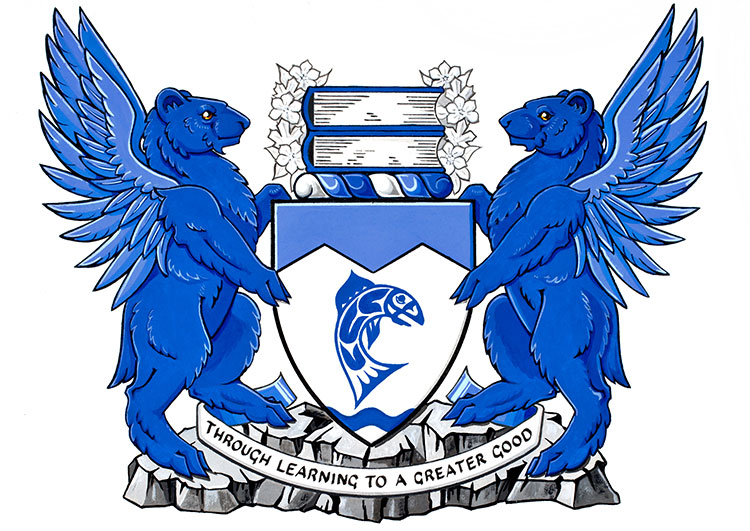
Arms
The main part of the shield is white, depicting a salmon.
Salmon are an important feature of local wildlife, and are shown here in the artistic style of the original inhabitants of the North Shore area.
The waves at the bottom of the shield indicate the University's location near the Pacific Ocean and the top section represents the nearby Coast Mountains.
Crest
Two books with blue binding and white pages are stacked with their bottom edges visible. On either side are several maple leaves and dogwood flowers, all in white.
This is set on a wreath of twisted cloth in white, light blue and blue. The books are a traditional symbol of education and the arrangement is inspired by the corporate emblem used when we were Capilano College.
The maple leaves and dogwood flowers make reference to the fact that the University is located in British Columbia, Canada.
Supporters
A bear in blue with light blue wings is depicted on each side of the shield. Each bear stands on a rocky base.
In local First Nations mythology, bears are symbols of strength and are a link between the natural and supernatural realms.
In medieval bestiaries, bears were said to give shape to their own young and, therefore, bears represent the "forming" of the young – a metaphor for education.
The wings refer to the idea of aspiration and can allude to ravens, another local creature immortalized in First Nations mythology, associated with intelligence and creativity.
The rocky base refers to the nearby Coast Mountains, which are a dramatic aspect of the local landscape.
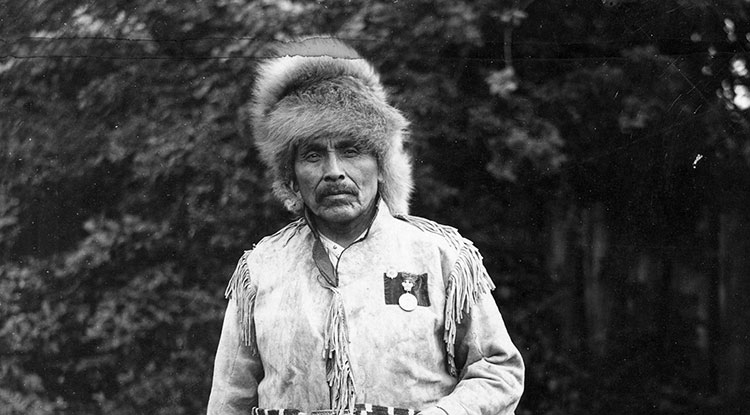
Photo: North Vancouver Museum & Archives, #2579. Photographer G.G. Nye
In 1968, residents of the North Shore submitted names for the newly-formed regional college operating on the grounds of West Vancouver Secondary School.
The name Capilano was selected to honour Chief Joe Capilano, a well-known Coast Salish carver and spokesperson on history and culture and advocate for education.
Born in 1850, Chief Capilano was a respected leader and chief of the Squamish Nation (Skwxwú7mesh). Skwxwú7mesh is a reference to "people of the sacred water," as the Squamish River was well known for its curative qualities.
Capilano University's North Vancouver campus sits on Skwxwú7mesh territory, which encompasses parts of the Lower Mainland and Sea-to-Sky Corridor.
In 1906, Chief Capilano led a delegation of B.C. chiefs to England and met with King Edward VII. While there, he was introduced to Canadian poet, Pauline Johnson. They became good friends, and after she moved to B.C.'s West Coast, Chief Capilano shared his legends, which she later recounted in her books and poetry.
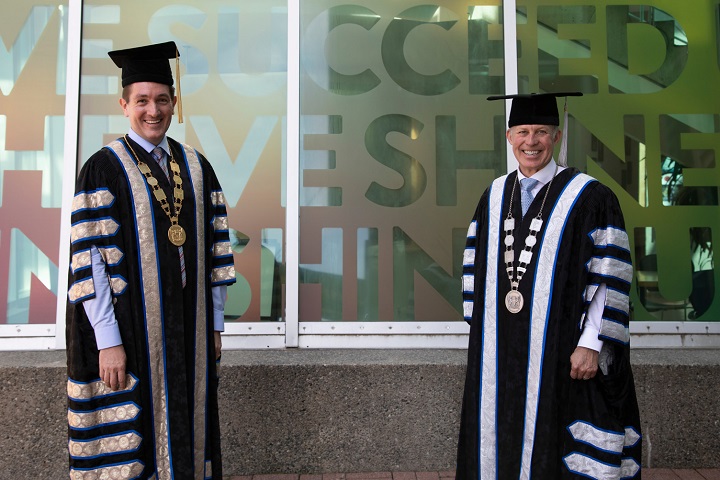
Capilano University's chancellor and vice-chancellor robes are based on traditional academic ceremonial gowns.
The chancellor's gown is black brocade with a woven dogwood flower motif, trimmed in gold brocade and edged with royal blue silk trim.
The dogwood is British Columbia's official flower. The four gold bands on both the upper and lower gothic sleeves represent Capilano University's four decades as a college, before becoming a university.
The vice-chancellor's robes are in the same black brocade with the dogwood motif, trimmed in silver brocade and edged with royal blue silk.
The robes were designed by Jane Still from CapU's Costuming for Stage and Screen program in the School of Motion Picture Arts. They were built by Deborah Gyug, a master of costume construction.
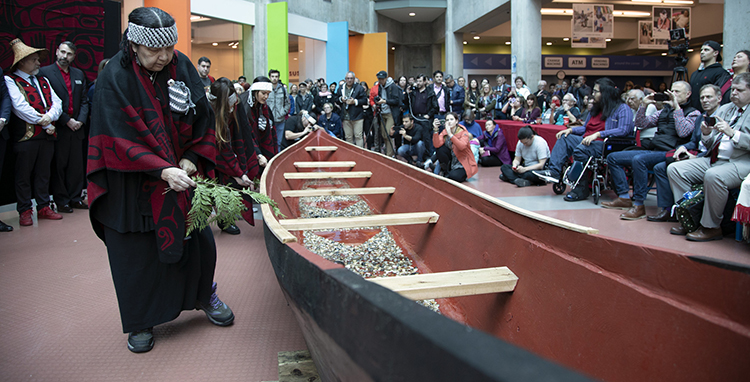
In celebration of our 50th anniversary, Capilano University commissioned Squamish Nation master carver Ses siyam (Ray Natraoro) to build a traditional Coast Salish canoe as a legacy to future generations and a symbol of the University's commitment to Truth and Reconciliation.
The 30-foot-long seaworthy canoe, named Skw’cháys in the Squamish Nation language, was carved at the North Vancouver campus in the winter of 2019, giving students, employees and the community the unique opportunity to witness the transformation from tree to canoe and learn firsthand about Coast Salish traditions and culture.
The canoe is present at Convocation as a physical reminder of our students' journey at CapU and for all the journeys they will take in the future.

The mace depicts the authority vested in the University to grant degrees, and also incorporates the history and tradition that surrounds both the territory near our regional campuses and the vision of Capilano University.
The mace's design portrays the unique territorial qualities of our region, which extends from Deep Cove to Mt. Currie to Earl's Cove on the Sunshine Coast.
These qualities include reference to the animal world, to the landscape, to directional symbolism and to the human element.
The mace is carved from yew, which is a natural wood found in our region. The mace was carved by Xwalacktun OBC (Rick Harry government given name) a Squamish Nation artist whose works are recognized internationally.
Responsibilities for bearing the mace originated in the office of the Bedellus or Beadle and date back to the University of Glasgow, which was founded in 1451.
The function of the Bedellus was to keep the students in order and, on the days of public functions, they arranged the seats for dignitaries.
The duties of the Bedellus have varied greatly over the centuries. In the 17th and 18th centuries, the incumbent was required to regulate bonfire settings and purchase university supplies.
Officially, the Bedellus is responsible for administration of the university's facilities. The most prominent role of the Bedellus was, and continues to be on ceremonial occasions, leading the academic procession and carrying the university mace.
